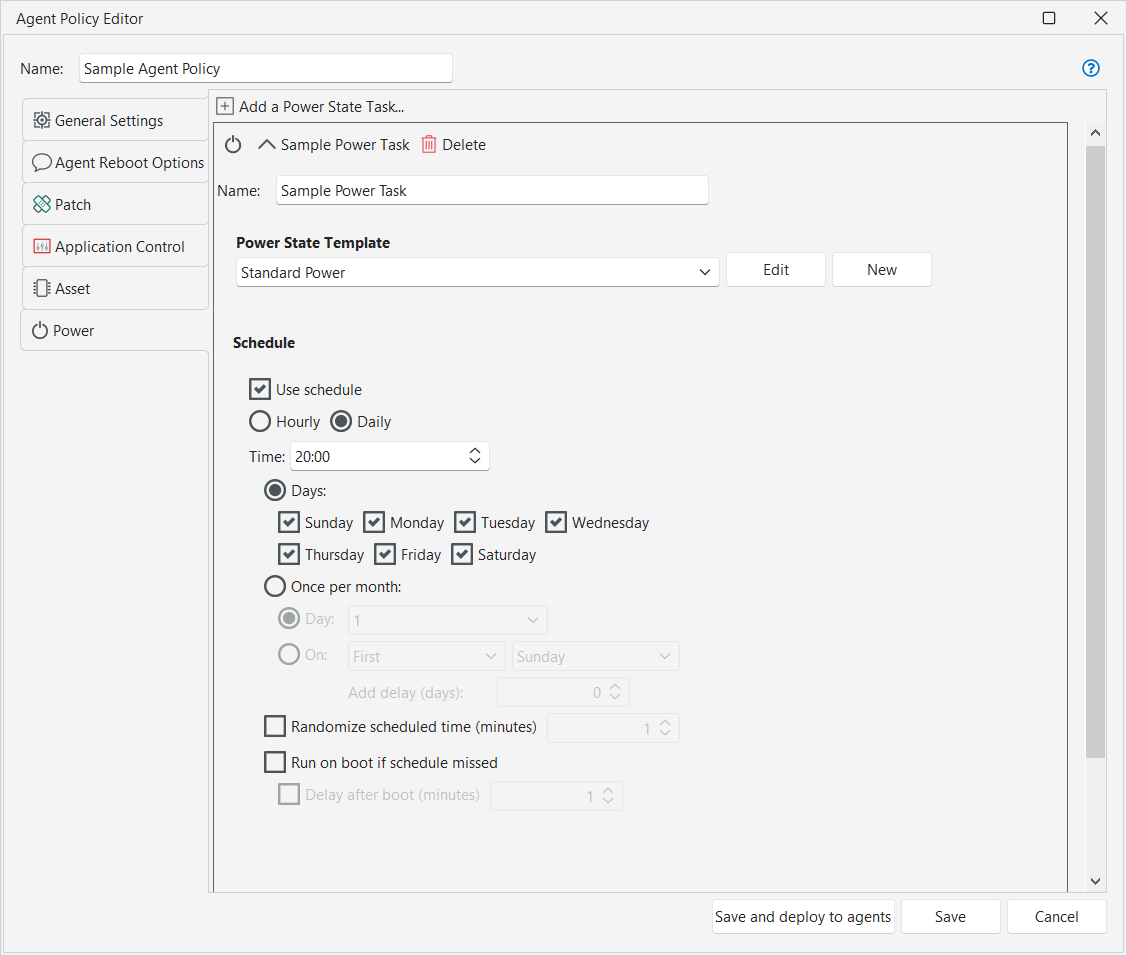Creating a New Power Task
A power state task is used to shut down or restart the target machines and to specify what power state to leave the machines (fully powered on, sleep state, hibernate state, or powered off). If you do not create a power task, then no power state tasks will be performed by agents that are assigned this policy. For information as to why you might want to use an agent-based power state task, see When should I use each solution?. For background information about the power management feature, see Power Management Overview.
You can create multiple power tasks for one agent policy. Each task can be expanded and collapsed using the triangle that resides on the task title bar. This enables you to view just the task you are working on at any one time.
While there is no theoretical limit to the number of power tasks you can create for an agent policy, there is a practical limit. For example, it may become difficult to track and manage a policy if it contains too many power tasks.
You configure agent asset tasks on the Power tab. You can edit an existing power task, or you can create a new task by clicking Add a Power State Task.
|
Field |
Description |
|---|---|
|
Power State Template |
You must specify the template to use when an agent performs a power task. The power state template dictates if and when the agent machines will be shut down or restarted, what control a logged on user will have over the reboot process, and what power state the machine will be left in. The list of templates available for selection will include the predefined template (Standard Power) plus any custom templates you've already defined. You can also do the following:
If you click New or Edit, the Power State Template dialog is displayed. See Creating and Editing a Power State Template for details on configuring the template. |
|
Schedule Area |
The power task schedule specifies how often the task will run on a target machine. It allows you to regularly run the task at a specific time or using a specified recurrence pattern. A built-in scheduler will be provided for each agent. The agent scheduler will serialize executions of the same agent engine. For example, if you define a policy with two power state tasks that both start at 1:00 AM, they will not both start at 1:00; rather, they will be serialized (run back-to-back). If you have a power state task and a patch task both scheduled for 1:00 AM, however, they will both be started at 1:00 AM as they use different agent engines. |
|
Use schedule |
If enabled, the task will run on agent machines on a recurring basis according to the schedule settings. If not enabled, the schedule settings are ignored and the task must be started manually from the console. |
|
Hourly |
Allows you to schedule the task to be run on an hourly basis.
|
|
Daily |
Indicates that the task will be run on the specified days, at the time of your choosing. For example, using this option a task could be run every night at midnight, or every Saturday at 9:00 pm, or at 1:00 am the first Sunday of every month, etc. You can also use the Daily option to schedule a task in conjunction with a regular monthly event such as Microsoft's Patch Tuesday. For example, you might schedule a monthly power task to occur the day after Patch Tuesday by specifying The Second Tuesday and then using the Add delay (days) option to delay the task by one day. |
|
Randomize scheduled time (minutes) |
Staggers the exact time the task will be performed. This is probably most useful if a large number of agents will be performing this power task and you don't want all your machines shutting down or restarting simultaneously. |
|
Run on boot if schedule missed |
If a scheduled task is missed while a target machine is powered off, this option enables you to force the task to automatically run whenever the machine is restarted. The task will run immediately unless you enable the Delay after boot (minutes) check box, in which case the execution will be delayed by the specified number of minutes. |
|
Save and update Agents |
Saves all changes to the policy file and stores it on the console. Also updates any agent machines that are currently assigned this policy as follows:
The Agent Policy Editor will be closed. |
|
Cancel |
Indicates you want to exit the Agent Policy Editor without saving your most recent changes. A "Do you want to save your changes?" prompt will appear that gives you a second chance to save your changes. If you click Yes the policy will be saved and the associated agents updated (the same as Save and Update Agents). If you click No the Agent Policy Editor will be closed without saving your changes. |
